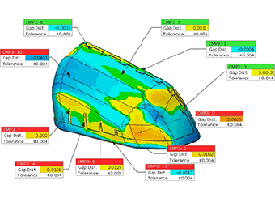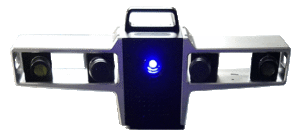First Article Inspection (FAI) is a formal, documented inspection used to verify that a manufactured part meets the required quality specifications. These inspections are required procedures in the medical, automotive, and aerospace industries, and can be beneficial for any production parts with critical dimensions and tolerances. In this article, we’ll discuss the process of a FAI, when and why to perform a FAI, and how 3D scanning may benefit the process.
The Process of FAI
Before diving into the process of FAI, it is perhaps best to explain what a First Article is. Contrary to its name, a First Article is not necessarily the first part produced in the mass manufacturing process. Rather, it is a sample part or series of parts taken from the first production run. A First Article must be a part that is produced by the exact means you plan to use for the entire production run. This includes using the same material, machinery, environment, and processes. For this reason, prototypes of the part, which are typically custom made before mass manufacturing, cannot be used for a FAI.
In tandem with selecting the First Article for the inspection, it is important to know what characteristics of the part will be checked. These characteristics may include wall thickness, weight, density, rigidity, color, surface finish, and position, diameter, and shape of holes or threads. While this list is largely dependent upon the requirements or requests of the buyer, the First Article is always tested for characteristics regarding its function, safety, and construction.
 For characteristics requiring measurements, the dimensions are typically taken via CMM probe or a 3-axis measuring system. However, in recent years, there has been a movement to transition to 3D scanning to capture the part’s entire physical geometry for inspection purposes. Once the dimensions are obtained, all of them, not just the critical ones, are compared to the original design drawing or CAD file. The comparisons and deviations from the original design are recorded in a First Article Inspection Report (FAIR). FAIRs use diagrams and ballooned drawings to indicate where deviations have been found between the intended design and the actual part. These reports may also include color maps and 2D slices with labels of the differing dimensions to indicate whether the part is in or out of tolerance.
For characteristics requiring measurements, the dimensions are typically taken via CMM probe or a 3-axis measuring system. However, in recent years, there has been a movement to transition to 3D scanning to capture the part’s entire physical geometry for inspection purposes. Once the dimensions are obtained, all of them, not just the critical ones, are compared to the original design drawing or CAD file. The comparisons and deviations from the original design are recorded in a First Article Inspection Report (FAIR). FAIRs use diagrams and ballooned drawings to indicate where deviations have been found between the intended design and the actual part. These reports may also include color maps and 2D slices with labels of the differing dimensions to indicate whether the part is in or out of tolerance.
It is important to note that FAIs can be performed by both the supplier and the purchaser. This allows the supplier to ensure that their manufacturing process is adequate and that the purchaser is satisfied with the quality for which they’re paying. Sometimes, the supplier or purchaser will outsource their FAI, usually to a metrology lab or another third party service provider. This is often done when the supplier or purchaser cannot perform the necessary testing of the First Article in-house. Other times, it is because a certification is either required or recommended for the FAIR.
When & Why to Perform FAI
By nature of its name, it may seem like FAI only needs to be performed once per part. However, this is far from the truth. A FAI needs to be conducted every time something changes either in the production process or the part’s design.
The reasons for performing a FAI on a part may include the following:
- it is a new part
- a new supplier or location of manufacture is being used
- a design or material change has been made that may affect function or fit
- the manufacturing process has been changed
- new tooling, machines, or methods of manufacture are being used
The reason FAI is recommended in all of these instances is to ensure your quality requirements are consistently understood and met. If there is miscommunication between the supplier and purchaser or if there is something amiss in the production process, it is best to know early. A FAIR allows for an objective, documented confirmation that these problems are avoided and corrected if necessary. This way, your part’s quality consistently conforms to the required and agreed upon specifications.
Because FAI allows you to catch and correct errors prior to the mass manufacturing process, the payoff can be enormous. A FAI helps prevent defect trends, which can ruin a whole production run and result in a high cost to fix the errors. As such, you can avoid product delays, recalls, and unhappy consumers.
3D Scanning for FAI
 As stated above, there has been a transition where 3D scanners are increasingly being used for FAIs. This is because 3D scanners greatly increase the speed at which the dimensions of a First Article can be recorded. As opposed to CMM probes, 3D scanners can generate thousands of data points from a part per second. CMM probes, on the other hand, only produce one point per touch of the probe. As such, dimensions are taken faster and the FAIR can be produced in a shorter amount of time.
As stated above, there has been a transition where 3D scanners are increasingly being used for FAIs. This is because 3D scanners greatly increase the speed at which the dimensions of a First Article can be recorded. As opposed to CMM probes, 3D scanners can generate thousands of data points from a part per second. CMM probes, on the other hand, only produce one point per touch of the probe. As such, dimensions are taken faster and the FAIR can be produced in a shorter amount of time.
An additional benefit of 3D scanning for FAI is that scanners are non-contact. If the part is delicate, a CMM touch probe may not be the best method for the job. This is especially true of internal geometry. Computed tomography (CT) scanning can capture the dimensions of a part’s internal geometry by non-destructive means via the use of X-rays.
Ultimately, the choice between 3D scanning and CMM probe depends on the part’s size, complexity, and need for internal geometry inspection.
First Article Inspection at 3 Space
Here at 3 Space, we offer a variety of 3D scanning services, including laser, structured white light, structured blue light, and CT scanning. Our technicians have a wealth of experience in operating these scanning technologies and conducting part inspection reports, including FAIRs. For assistance in choosing a technology for your FAI, our technicians can offer suggestions based on your part’s design and the amount of dimensions you require. For more information, contact us today.
